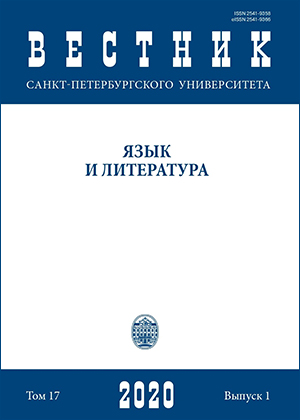Микромачизм в современном испанском языке и культуре
DOI:
https://doi.org/10.21638/spbu09.2020.106Abstract
The article is devoted to one of the most acute problems of modern society — gender inequality. The author analyzes the state of the Spanish and Latin American society through the prism of the lexeme micromachism and its function in speech. The interest in the linguistic and lexical-semantic analysis of the word micromachism is triggered by the wide use of the word in the periodical press in Spanish, as well as the direct interconnection of the lexeme and the problem of violence against women in the modern Spanish-speaking society. The meaning of the word micromachism and its correct use in speech were firstly described in the recommendations of the Spanish Foundation BBVA — an organization dedicated to the popularization of the Spanish language, and also seeking to improve the Spanish language of the mass media. Later, the word among 11 other nominees was nominated for the title of “word of the year”. Despite the fact that it did not become a winner, it attracted the attention of linguists, sociologists, and journalists to the problem of the functioning of micromachism in modern Spanish speech. The main research materials are the corpus of the Spanish language, explanatory dictionaries, dictionaries of neologisms and banks of lexical data. An analysis of texts from periodicals to identify the frequency of use of the lexeme micromachism carried out by the author confirms the official statistics of abuse of women in some countries of Latin America and Spain. As for the Russian language, the author in his study addresses only the National Corpus of the Russian language and explanatory dictionaries to reveal how often the lexical unit is used in the Russian language and whether it is recoded in dictionaries. The author does not aim to study the situation of gender inequality in Russia and its reflection in the language. In addition to the widespread illumination of the problem in the periodical press in Spanish, the phenomenon of micromachism is actively studied in the scientific field, which once again confirms the severity of the problem in modern society.
Keywords:
word of the year, micromachism, language of mass media
Downloads
References
Котовская, Шалыгина 2005 — Котовская М.Г., Шалыгина Н.В. Анализ феномена мачизма. Общественные науки и современность. 2005, (2): 166–176. http://ecsocman.hse.ru/data/2010/12/15/ 1214861781/Kotovskaya.pdf (дата обращения: 31.07.2019).
Кофман 1997 — Кофман А.Ф. Латиноамериканский художественный образ мира. М.: Наследие, 1997. 320 с.
Фирсова 2009 — Фирсова Н.М. Избранные труды. Т. 1: Актуальные проблемы грамматической стилистики и разговорной речи испанского языка. М.: Изд-во Рос. ун-та дружбы народов, 2009. 622 с.
Bonino 1995 — Bonino L. Desvelando los micromachismos en la vida conyugal. В кн.: Corsi J. Violencia masculina en la pareja: Una aproximación al diagnóstico y a los modelos de intervención. Buenos Aires: Paidós, 1995. P. 191–208.
Comunicación 2018 — Comunicación, género y educación: Representaciones y (de)construcciones. Suárez Villegas J.C., Marín Conejo S., Panarese P. (eds.). Madrid: Editorial Dykinson, 2018. 553 p.
Landa 2015 — Landa V. Piropos: micromachismos cotidianos disfrazados de halagos. La izquierda diario. Дата публикации: 12.11.2015. http://www.laizquierdadiario.com/Piropos-micromachismos-cotidianos-disfrazado-de-halagos (дата обращения: 31.07.2019).
Marín Traura, Rodríguez del Pino 2018 — Marín Traura S., Rodríguez del Pino J.A. Trabajar los micromachismos con alumnado desmotivado: La experiencia en el PCPI–PFCB en el municipio de Chiva (Valencia), 2012–2016. В кн.: Comunicación, género y educación: Representaciones y (de) construcciones. Suárez Villegas J.C., Marín Conejo S., Panarese P. (eds.). Madrid: Editorial Dykinson, 2018. P. 307–312.
References
Котовская, Шалыгина 2005 — Kotovskaya M.G., Shalygina N.V. Analysis of the phenomenon of machism. Obshchestvennie nauki i sovremennost’. 2005, (2): 166–176. http://ecsocman.hse.ru/data/2010/12/15/1214861781/Kotovskaya.pdf (access date: 31.07.2019). (In Russian)
Кофман 1997 — Kofman A.F. Latinoamerican self-image of the world. Moscow: Nasledie Publ., 1997. 320 p. (In Russian)
Фирсова 2009 — Firsova N.M. Selected works. Vol. 1: Actual problems of grammatical stylistics and colloquial speech of the Spanish language. Moscow: Peoples’ Friendship University of Russia Press, 2009. 622 p. (In Russian)
Bonino 1995 — Bonino L. Desvelando los micromachismos en la vida conyugal. In: Corsi J. Violencia masculina en la pareja: Una aproximación al diagnóstico y a los modelos de intervención. Buenos Aires: Paidós, 1995. P. 191–208.
Comunicación 2018 — Comunicación, género y educación: Representaciones y (de)construcciones. Suárez Villegas J.C., Marín Conejo S., Panarese P. (eds.). Madrid: Editorial Dykinson, 2018. 553 p.
Landa 2015 — Landa V. Piropos: micromachismos cotidianos disfrazados de halagos. La izquierda diario. Publication date: 12.11.2015. http://www.laizquierdadiario.com/Piropos-micromachismos-cotidianos-disfrazados-de-halagos (access date: 31.07.2019).
Marín Traura, Rodríguez del Pino 2018 — Marín Traura S., Rodríguez del Pino J.A. Trabajar los micromachismos con alumnado desmotivado: La experiencia en el PCPI–PFCB en el municipio de Chiva (Valencia), 2012–2016. In: Comunicación, género y educación: Representaciones y (de) construcciones. Suárez Villegas J.C., Marín Conejo S., Panarese P. (eds.). Madrid: Editorial Dykinson, 2018. P. 307–312.
Downloads
Published
How to Cite
Issue
Section
License
Articles of "Vestnik of Saint Petersburg University. Language and Literature" are open access distributed under the terms of the License Agreement with Saint Petersburg State University, which permits to the authors unrestricted distribution and self-archiving free of charge.






